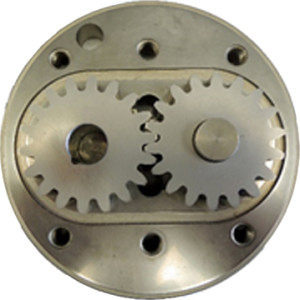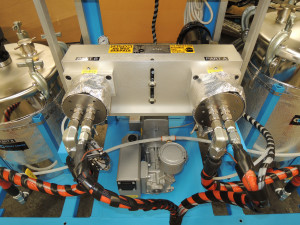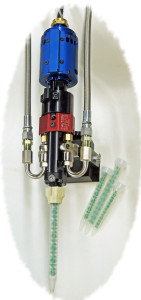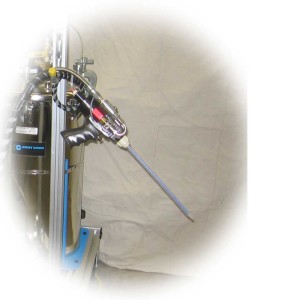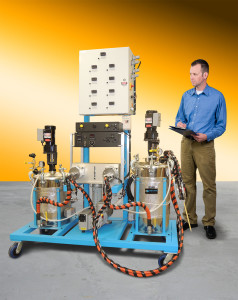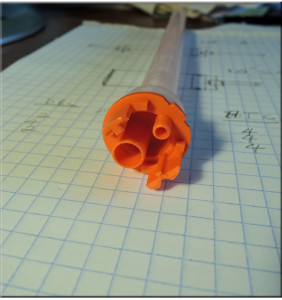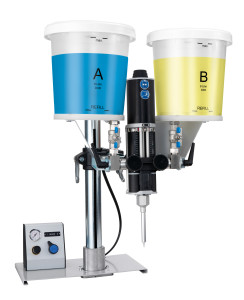Ashby Cross 3800 Meter, Mix and Dispense System
Designed for Highly Filled, Abrasive Materials
∞
The Ashby Cross 3800 Single Acting meter, mix System’s design is based on our 2500 series meter mix system design.
It is cylinder and piston metering which provides excellent ratio performance (within 1% by volume) and repeatability. In-line metering ensures both metering pistons move simultaneously which eliminates the phasing seen in parallel configurations.

When coupled together on a common shaft the metering pistons effectively become a single unit, that is, if the A piston moves the B piston moves an equal amount. The volume ratio is achieved by matching the two cylinder’s relative volumes to the mix volume ratio of the adhesive.
The major difference between the 3800 system and the 2500 system is the volume of the metering cylinders.
The 3800 system is designed to produce just over twice the volume of material per stroke than the 2500 series. When processing materials with abrasive filler such as silica, this difference extends the useful life of the piston and cylinder by a factor of two. Hardened, chrome plated cylinders are designed for high abrasive processing.

3800 Series metering cylinders are designed for longer life.

10-gallon stainless steel pressure/vacuum tanks with agitators
Hi/Low level sensors and heat.
The 3800 machine can be fed from totes or 55-gallon drums – generally the material, due to high filler content and relatively high viscosity, needs to be prepared before entering the metering system. Preparation is generally done by inserting day tanks between the bulk feed supply and the metering. These tanks can be used to agitate, heat, and or degas the material. Agitation is almost always necessary. Tank size is usually determined by material use.
Tanks may be designed to automatically fill from bulk supply or can be manually filled. Hi/Low level sensing with alarms assist the operator during the refill cycle.
For high viscosity materials tank heating is employed to reduce the viscosity which provides better machine performance, better mixing, and faster part filling.
Heating is done with the use of an electric resistance coil located outside the belly of the tank. The coil is encapsulated in high-performance thermal compound and a thermocouple is attached to the tank bottom.
The thermocouple feeds a proportional controller that regulates the current to the heating element, reducing as the temperature rises to prevent overheating. This heating method is extremely effective, reliable and repeatable.
Vacuum degas options remove air from the tanks which is essential in wide ratio material applications. Air within the material is a major contributor to off-ratio problems.

On-board vacuum pumps degas the material in the day tanks
Flow control is achieved with 4-way rotary valve not ball check valves. 4-way valves direct the incoming flow into the metering cylinder where the ratio is established. Once full, the valves rotate 90 degrees, shutting off the incoming flow and connecting the cylinders to the mix/dispense valve.
How it works

The Resin and Catalyst cylinders have a respective volume matching the volume mix ratio of the material to be processed. For instance, if the material has a 2:1 mix ratio (Resin:Catalyst) then the catalyst cylinder will have a volume equal to ½ the volume of the resin cylinder.
In the fill operation, air pressure in the drive cylinder is removed. Each 3-way rotary valve (driven by a common actuator) rotates to the recharge (fill) cycle. Tank pressure or transfer pumps drive the material into the metering cylinders where the specific volume ratio is determined.
Once the cylinders are full the 3-way rotary valves rotate 90 degrees isolating the feed supply and connecting the metering cylinders to the mix/dispense valve. The Drive Cylinder is actuated and drives proportioned material to the dispense point.
 Sealing Advantages
Sealing Advantages






 Sealing Advantages
Sealing Advantages